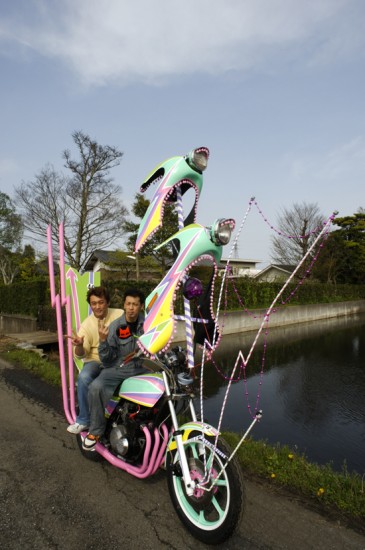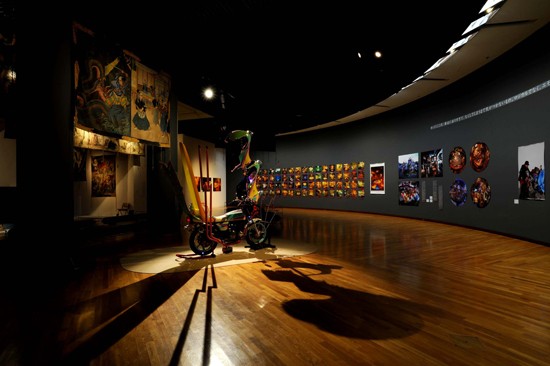Pimping Rides the Bosozoku Way
The Saturday night silence of a sleepy suburban neighborhood is shattered by a sudden, exploding chorus of exhaust pipes. Engines rev with a deafening vroom and horns perform an endless looping melody, in a call-and-response ritual reminiscent of jungle drums, echoing around the forest of concrete and glass. Then, after a ridiculous interval, invariably long after the horse has bolted, so to speak, the shrieking sirens of patrol cars giving chase. Yes, it’s that regular feature of the contemporary Japanese landscape: the passeggiata of the bosozoku street racers.
Just as prostitution has been around since the dawn of human history, so the bosozoku in some form or another have been around throughout the history of the internal combustion engine. If car and bike racing were sports of the privileged classes – street fighting with rules, perhaps – charging about the streets at high speed became also a challenge and a provocation to the people who made the rules.

As illustrated vividly by the appellation kaminari-zoku or “thunder tribe” given to the bands of petrolheads that took over Japan’s nighttime thoroughfares in the early 1960s, the bosozoku are people who “boso suru” (drive recklessly) and break traffic laws. Originally this meant moving at speed. Modifying their machines to wring the last inch of performance out of them; ignoring all safety measures such as speed limits, traffic signals and helmets; occasionally showing a blatant disregard even for their own lives, these early racers dedicated themselves to driving, or riding, as fast as they could. This is the fundamental aesthetic of the street racer, and the very reason young people in New Jersey, Liverpool and Bangkok still dice with death in nightly displays of speed.
However from the second half of the 1970s into the early ’80s a revolutionary turnaround occurred in Japan, ironically by then home to the fastest motorcycles on the planet. The bosozoku began to move not quickly, but slowly. The over-the-top throaty idling may have sounded like a racing circuit, but in fact they were now riding, or driving, at walking pace, and taking up the whole road. Japan’s after-dark street-racing tribes instinctively realized that bringing traffic to a standstill by almost “not driving” would be a greater threat to the authorities than zooming about breaking the speed limit.
The roar of engines and blare of horns were now no longer the sounds of cars and bikes, but the march of an army on the move. This aggressive volley of “metal music” was a fanfare resonating through the nighttime streets, announcing the start of the show: scaring off anyone unlucky enough to be on the stage – the road – and summoning the audience to their seats – the roadside.
And not to race, but to parade. The inevitable result of this switch from fast to slow was to transform bosozoku machines from weapons for driving to something more akin to portable festival shrines, designed to attract attention. The boom in over-the-top decorative modification of cars and bikes that sprang up simultaneously in the late 1980s in the cities of the capital’s commuter belt such as Chiba and Ibaraki; in regions such as Kansai, Fukuoka and all over the country, peaking around 1992, was the final word in bosozoku “pimping and parading” culture.
High-priced, high-powered, high-performance machines mean virtually nothing to these guys. And having dropped out of Japan’s suffocating education system at the earliest opportunity, they’ve very little to spend on their chosen mode of transport anyway. Generally speaking they start by acquiring the likes of a cheap, second-hand mid-range-cc bike, a hand-me-down from an older racer, or something stolen.
The sensible way to modify a car or bike would be to have it done by professionals at an auto shop, or at the factory. But in the vast majority of cases, bosozoku members do it themselves. Every team will have one or two skilled amateur mechanics, car painters and so on who take the lead in custom work carried out in backyards or at the roadside late at night.
When it comes to the actual types of modification, the main focus is inevitably on parts that will attract attention: “rocket”-style fairings, chopper seats, tailpipe extensions, megaphones, revolving lights, air horns and so on. In contrast, performance-enhancing work such as engine tuning scarcely gets a look. Especially interesting are the distinct regional differences in styling: “Chibaraki specs” in Chiba, Ibaraki and Gunma where bikes rival each other in the angle and height of their fairings; “Fukuoka specs” resulting in machines known for their distinctive “color-explosion” paintwork and “Kansai specs” consisting of seats covered in gaudy fabrics featuring patterns such as leopard skin and Kinkazan brocade.
In today’s Japan, dominated by an information system with a mass media over-concentrated in the capital, and a flow of information almost exclusively one-way from Tokyo to the regions, the aesthetics of bosozoku modification are an example of something defiantly born and raised in the provinces that went on to gain national recognition. Late at night in family restaurants, or while gang members crouch in front of convenience stores clutching canned coffee, myriad reckless ideas have been dreamed up, tried and consigned to obscurity.
The kind of enthusiasts who get a kick out of buying expensive imported cars and motorcycles and fitting them with piles of high-priced accessories would doubtless find the bosozoku style incomprehensible. The commanding presence created by taking a cheap machine and painstakingly customizing it until virtually unrecognizable has a punk-like yet overwhelmingly baroque aesthetic. That challenging aesthetic is also an audacious finger to an auto industry obsessed with pointless high-performance point-scoring and model changes.

It’s the best part of 20 years now since those ultra-pimped-out bikes strutted their outlandish stuff on Japan’s public thoroughfares before riding off into the sunset. Keen to revive that dash and daring, I’ve included in my “Heaven” exhibition at the Hiroshima City Museum of Contemporary Art (through July 19) a famous bike of the time, customized specially for the show.
The modifications are courtesy of Mr Yuji Furuhashi of Misty in Yoga in Tokyo’s Setagaya-ku and Mr Kazuyuki Watanabe of the Japan Z Family band of bosozoku bikers. Both are battle-hardened former bosozoku leaders who commanded huge bands of racers in the heyday of the “parade” culture. And now the “MISTY custom bike for festival use” has descended on the rarified space of a contemporary art museum. Do go along to bathe in its powerful aura and admire originality of a sort found nowhere else on the globe. And if you doubt a bike like this can actually be ridden, take a look at the following footage shot somewhere in rural Japan on New Year’s Day 15 years ago.
All power to the local, not global. How can something so uncool be just so cool?
All photos Kyoichi Tsuzuki. ⓒ Kyoichi Tsuzuki.
